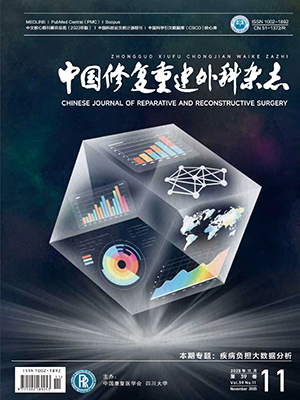Objective Aminoguanidine (AG) can reduce brain edema and increase the recovery of neuron functions in surgical brain injury and stroke. To investigate the effect of AG on spinal cord injury (SCI) in rats and its mechanism. Methods A total of 150 adult male Sprague Dawley rats (weighing, 230-255 g) were divided into control group (group A, 25 rats without treatment), the sham-operated group (group B, 25 rats undergoing laminectomy), SCI group (group C, 25 SCI rats with injection of 5%DMSO), SCI + AG groups (groups D, E, and F, 25 SCI rats and AG injection of 75, 150, and 300 mg/kg, respectively). The optimal dosage of AG was screened by dry-wet weight method with the percentage of water content at 0, 12, 24, and 48 hours after injury. The blood-spinal cord barriar permeability was further detected by Evans blue (EB) method, aquaporins 4 (AQP4) mRNA expression by RT-PCR, AQP4 protein expression by immunohistochemistry and Western blot. Results AG injection at dosage of 150 mg/kg can significantly reduce edema of spinal cords at 12, 24, and 48 hours after SCI (P lt; 0.05), so 150 mg/kg was the optimal dosage. The EB content in group E was significantly lower than that in group C at 12, 24, and 48 hours after SCI, and the permeability of blood-spinal cord barrier was significantly decreased compared with group C (P lt; 0.05). The AQP4 mRNA expressions in groups B and E were significantly lower than that in group C at 12, 24, and 48 hours after SCI (P lt; 0.05). AQP4 protein expressions in groups B and E were significantly lower than that in group C at 24 and 48 hours after SCI (P lt; 0.05) by Western blot. Immunohistochemical staining revealed that AQP4 protein expression in group C was significantly higher than that in groups B and E (P lt; 0.05) at 48 hours after SCI, but no significant difference was found between group B and group E (P gt; 0.05). Conclusion AG injection at dosage of 150 mg/kg can induce spinal cord edema and injury in rats, which could be correlated with the down-regulation of AQP4 expression.
Citation: FAN Zhongkai,CAO Yang,ZHANG Zhe,WANG Yansong,YU Deshui,ZHANG Mingchao,MEI Xifan,LUuml,Gang. EFFECT OF AMINOGUANIDINE ON SPINAL CORD EDEMA OF ACUTE SPINAL CORD INJURY IN RATS. Chinese Journal of Reparative and Reconstructive Surgery, 2012, 26(8): 984-988. doi: Copy
Copyright ? the editorial department of Chinese Journal of Reparative and Reconstructive Surgery of West China Medical Publisher. All rights reserved




